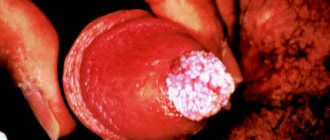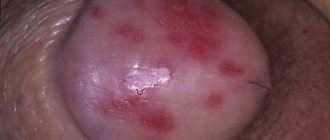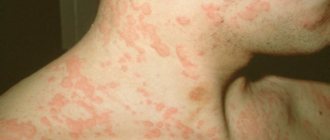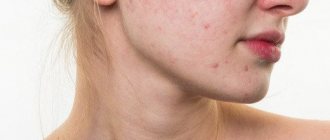Even small red spots on the head in men may indicate the presence of a fungal or venereal infection in the body. In most cases, spots are discovered after unprotected sexual intercourse, and this becomes the driving factor for making an appointment with a dermatovenerologist. Severe itching, swelling, redness, burning and pain during urination can also help you avoid delaying a visit to the doctor. But, there are cases when small spots on the head of the penis do not pose a serious danger and disappear within 1-2 days.
Causes of red spots on the penis
Some people believe that they can diagnose themselves based on this symptom alone.
To do this, just go to the Internet and see what they write about this on medical websites.
But in fact, it is impossible to determine the cause of red spots on the penis without a medical examination and testing.
Because there are many diseases, different in origin, that cause a rash.
This symptom is nonspecific.
If red spots appear on the penis, the reasons may be:
- inflammatory processes of the skin caused by opportunistic microorganisms;
- sexual infections;
- allergic reactions;
- skin diseases (psoriasis, dermatitis, lichen planus, etc.);
- mechanical damage to the penis;
- chemical burns, etc.
To find out why red spots appeared on the head of the penis, you need to:
- evaluate additional symptoms;
- examine the spots;
- conduct clinical tests;
- take tests.
All this is possible only in a medical facility.
Therefore, if a corresponding symptom appears, we invite you to our clinic.
An experienced dermatovenerologist is ready to see you here.
He will determine the cause of itching and red spots on the penis, and then prescribe treatment.
Features of treatment
Treatment for rashes on the penis depends solely on the cause of their occurrence. Sometimes it is enough for the patient to improve hygiene and change some daily habits (for example, give up tight underwear) for the skin condition to improve. If the doctor reveals the presence of any diseases, treatment is selected individually:
- Allergies require identifying the allergen and eliminating further contact with it. To neutralize unpleasant symptoms, antihistamines are used in tablet form - Cetrin, Loratadine, Zyrtec, etc.
- If candidiasis is diagnosed, the use of special antifungal drugs may be required. Most often, local application is sufficient - using a cream or ointment (for example, Clotrimazole). Additionally, patients are advised to maintain proper hygiene, adhere to a diet and strengthen their immune system.
- A pustular rash, which is a consequence of abnormal bacterial growth, can usually be successfully treated with local antibiotic ointments (Erythromycin, Syntomycin, etc.). The treatment regimen is selected on an individual basis.
- If the rash is a consequence of sexually transmitted diseases, targeted treatment of the identified disease is carried out. The patient may be prescribed antibacterial drugs for systemic use (tablets) and local agents for treating the genitals.
- For genital herpes, targeted antiviral treatment cannot be avoided. Typically, patients with this problem are prescribed acyclovir or famciclovir. Acyclovir ointment is used for topical application.
Scabies requires quite complex treatment. For this disease, doctors prescribe special ointments that need to be applied to the entire body. It is also necessary to carry out sanitary treatment of clothing, bed linen, etc. Papillomas on the genital organs are removed using medications (Imiquimod cream, etc.) or surgical treatment methods (laser or radio knife). Additionally, patients with HPV are prescribed medications that strengthen the immune system.
Red spots on the penis due to allergies
Allergic reactions have very diverse clinical manifestations.
These may be spots, papules, blisters, etc.
Sometimes inflammation upon examination looks exactly the same as an infectious process.
An allergy is a pathological reaction of the body to a certain substance.
An inflammatory reaction is triggered after it comes into contact with the skin, inhalation, ingestion, or intravenous administration.
It does not matter how the allergen entered the body.
A pathological reaction develops in any case.
It can occur immediately after the penetration of the allergen, if it is strong.
With a weak allergen, the reaction is less pronounced and appears later.
Sometimes red spots first appear on the penis only a few months after contact with the allergen.
Subsequently, when the body becomes sensitized, allergic reactions develop within a few minutes or hours.
Obviously, if the spots appeared due to an allergy only on the penis, and nowhere else, then they arose due to direct contact of the skin with the allergen.
It could be:
- lubricant;
- linen;
- drugs;
- spermicides;
- condom.
Allergic reactions can occur after sexual contact with a woman if she uses any intravaginal means: drugs or contraceptives to which the man is allergic.
After such contacts cease, the spots disappear.
Plasmacytic (Zoon) balanitis
Rice. 2 – Zoon-balanitis
A benign non-venereal disease of the penis, which is characterized by the appearance of a single red-orange, well-circumscribed plaque on the head. It most often develops in middle-aged and elderly men who have not undergone circumcision.
The exact cause of the pathology has not been established, but the main predisposing factors are phimosis, constant irritation and mechanical damage to the skin.
Apart from the plaque, a man may not be bothered by anything; pain and burning during urination are less likely to occur. Circumcision eliminates the manifestations; local ointments based on glucocorticosteroids and 5% imiquimod are also used in treatment.
Red spots on the penis due to an STD
Some sexually transmitted infections cause inflammatory processes on the skin of the penis.
The result is the appearance of spots and other elements of the rash.
Most sexually transmitted diseases primarily affect the urethra.
But some microorganisms are capable of parasitizing on the surface of the genital organ.
STDs that cause red spots include primarily:
- herpes;
- syphilis;
- candidiasis.
Other infections can also cause them.
But this happens much less often.
And at the same time, as a rule, there are symptoms of urethritis.
This could be chlamydia, trichomoniasis, gonorrhea.
Preventive measures
In order to avoid problems with red formations on the penis, you must adhere to generally accepted rules of personal hygiene . In case of casual sexual contacts, it is necessary to use contraception , not to wear other people's underwear, not to use other people's towels, and nightly showers or other water procedures should become mandatory.
A healthy diet with the required amount of greens, vegetables and fruits will help strengthen the immune system. This in turn will allow the body to remain resistant to the effects of many infections.
Various changes in the normal state of the genital organs should in no case be ignored. After all, such symptoms can indicate many health problems - from allergies to cancer.
Red spots on the penis due to herpes
In most cases, with a herpetic infection, it is not spots that appear on the penis, but vesicles.
The appearance of red spots when infected with this virus is possible in the following cases:
- atypical form of herpetic infection;
- relapse of herpes (it is usually milder than the initial episode of inflammation of the skin of the penis);
- the initial period of the disease, when spots appear, and soon bubbles will appear in their place.
Herpes is transmitted through sexual intercourse with a partner who at the time of contact has a rash on the genitals.
During the period of remission, a person is not contagious.
The infection progresses in waves.
Periods of exacerbations give way to stages of latent course.
Initially, after infection, blisters or red spots appear on the head of the penis.
Elements of the rash also appear on other areas of the skin of the anogenital zone.
After 2-3 weeks the symptoms go away.
If therapy is prescribed in a timely manner, the spots may disappear earlier - after 1-2 weeks.
Then comes a period of remission.
There are no rashes.
There are no symptoms.
But sooner or later a relapse occurs.
This often happens due to hypothermia, decreased immunity, or severe illness.
Relapses are easier.
Symptoms last 1-2 weeks.
During this period, a person is contagious and should not have sexual intercourse.
The weaker the immune system, the more frequent, severe and longer the relapses.
Precancerous conditions
10.1. Bowenoid papulosis
The disease develops against the background of infection with papillomavirus types 16, 18, 34, 39, 40, 42, 45. Rashes in the form of papules, multiple, small, appear on the head and foreskin and gradually merge into one large, flat plaque, their color is red-brown or gray-brown. Bowenoid papulosis can transform into cancer.
The main method of treatment is surgical excision/cauterization of the affected areas (CO2 laser, cryodestruction).
10.2. Erythroplasia Keira
Malignant tumor of the head of the penis in situ (non-invasive tumor). The foreskin may also be involved in the pathological process (single or multiple red neoplasms with clear edges are detected on the skin).
The disease affects men who have not undergone circumcision. Over time, the tumor may grow deeper into the tissue. The main treatment is surgical excision. The patient is also recommended to undergo circumcision.
Red spots on the penis due to candidiasis
A fungal infection of the penis in the vast majority of cases manifests itself as a spotty rash.
It is also possible:
- the appearance of papules, erosions, pustules;
- white plaques, under which the hyperemic mucosa opens;
- sour smell.
Pathology develops for two reasons:
- unprotected sex (sexually transmitted from a woman suffering from candidiasis);
- weakening of the immune system.
Candida fungi live on the penis of any person.
But there are not many of them.
In such quantities, Candida is completely safe.
It is completely controlled by the immune system.
But in some cases there is a significant increase in the fungal population.
As a result, a red spot and itching appears on the head of the penis.
Other symptoms also progress.
Triggering factors can be:
- serious illness or surgery;
- insufficient genital hygiene;
- hypothermia;
- hot climate or excessive sweating (fungi multiply in a humid and warm environment);
- uncontrolled use of antibiotics (they suppress the bacterial flora that competes with fungi);
- use of drugs that suppress the immune system (glucocorticoids, cytostatics, immunosuppressants).
In most cases, the disease is easily treatable.
Severe clinical course is typical only for immunodeficiencies.
Candidiasis is one of the opportunistic infections that rapidly progress against the background of HIV.
Red spots on the penis due to folliculitis
This term refers to inflammation of the hair follicle.
Most often, several bulbs are involved in the inflammatory process.
There is hair on the penis.
Accordingly, folliculitis can also develop here.
The most common pathogen is staphylococcus.
The superficial inflammatory process caused by it is called ostiofolliculitis.
With greater depth of the lesion, sycosis is diagnosed.
It carries significant risks, as it can transform into a boil.
This is an extensive focus of inflammation with a purulent cavity.
Main symptoms:
- red spots appear;
- they turn into papules, and then into pustules - ulcers;
- pain is felt at the site of inflammation, which intensifies with palpation;
- Lymph nodes may become enlarged.
Folliculitis may also have another etiology.
It can be pseudomonas, fungal, viral, etc.
Red spots on the penis with nonspecific balanoposthitis
Nonspecific bacteria sometimes cause inflammation of the penis.
Multiple red spots appear on the head of the penis and foreskin.
They are irregular in shape and can have a wide variety of diameters.
Tend to grow along the periphery and merge.
Sometimes several spots merge, forming a fairly large inflamed surface.
The etiology of the process varies.
Balanoposthitis can be caused by aerobes, anaerobes, and fungi.
Main reasons:
- lack of hygiene;
- reduced immunity;
- infection with candida, gardnerella or another microorganism during sexual intercourse;
- introduction of infection from one’s own body (for example, introduction of Staphylococcus aureus from the nasopharynx);
- sweating;
- accompanying pathological processes (fever, thyrotoxicosis, diabetes mellitus and others).
With this disease, red spots appear and plaque accumulates on the surface of the penis.
Purulent discharge may appear.
There is an unpleasant odor coming from the penis.
The pathology can be mild in some patients and severe in others.
With a mild course, the matter is limited to only red spots.
Pain occurs only with palpation or friction.
The disease goes away quickly with treatment.
It can go away even without treatment, although recovery will take longer.
But there are also severe inflammatory processes.
Progression of balanoposthitis is possible without treatment.
And also if the main factors that cause the formation of red spots are not eliminated.
Then erosions, cracks, and ulcers appear.
There is severe pain and swelling of the penis.
Methods for preventing the disease
Poor personal hygiene can lead to unpleasant symptoms in the penis and foreskin, especially in uncircumcised men.
In order to avoid this problem, it is very important to monitor your penis and keep it clean. Uncircumcised males should remember the importance of regularly cleaning the foreskin of dirt.
The use of cream for intimate areas can restore the normal state of pores, as well as protect the skin of the genital area from difficulties associated with diaper rash, infections of bacterial or fungal origin, as well as various redness.
The main cause of balanoposthitis among children is the reduction of the foreskin, when it is not possible to pull it back. This is a dangerous condition that promotes infection and redness.
Redness of the genitals is also observed among adolescents who tend to ignore hygiene procedures and, as a result, there is an accumulation of too much smegma, which collects under the head of the penis and causes not only redness, but also a burning sensation. There is a high risk of complications and the emergence of chronic forms of diseases among children, since adolescents do not always share their problems with their parents and do not consult doctors in a timely manner.
Red spots on the penis due to rubbing
It happens that a spotty rash occurs without any disease.
It is formed as a result of rubbing.
When friction occurs, damage occurs to the surface layer of the skin.
Mild inflammatory reactions occur in this area.
Local dilation of blood vessels occurs.
As a result, red spots form on the skin of the penis.
When the impact of the traumatic factor ceases, the damage heals quickly if it is superficial.
Red spots on the head of the penis after sex
If you notice that spots appeared after sexual intercourse, there may be a lot of reasons for this.
Here are some of them:
1. Traumatic injuries to the penis.
Perhaps you were too zealous and rubbed your penis.
In this case, the stains are not scary.
It is enough to restrain your ardor for a few days, and all the damage will heal.
You can also use antiseptics to prevent infection.
It should be remembered that during sexual intercourse with a rubbed penis, the risk of transmitting dangerous diseases increases.
Including HIV and viral hepatitis.
2. Allergies.
For example, the latex from which a condom is made.
Or for lubricants.
Perhaps an allergic reaction after sex was triggered by spermicides.
Or maybe these are the drugs that the woman uses.
After all, even if she used a vaginal pill a day ago, its remnants could remain in the vagina and get on the penis during sexual intercourse.
3. Sexual infections.
In this case, red spots do not appear immediately.
Until this moment it may take several days, and sometimes even a month.
Therefore, the connection with sexual intercourse cannot always be established.
Herpes, gonorrhea, and trichomoniasis appear most quickly.
Symptoms may appear in a week or less.
But among these infections, only herpes often causes red spots on the penis.
Whereas gonorrhea and trichomonas mainly affect the urethra.
When to go to the doctor
By taking a shower or changing synthetic underwear to clothes made from natural fabrics, you can get rid of non-infectious stains in a few days. If the measures taken do not help, the spots do not disappear, and additional symptoms appear, then contacting a doctor becomes the only right decision. Remember that infections can spread to internal organs, so do not hesitate to visit the clinic. If you feel slightly unwell, you can go to a urologist. The specialist will diagnose and prescribe competent treatment, and if necessary, refer you to doctors of another profile - a venereologist, allergist or dermatologist.
What tests should I take for red spots on my penis?
To carry out effective treatment, you need to know what causes the spots.
This can be determined using laboratory tests.
Typically, patients who present with such complaints undergo the following tests:
- blood for syphilis;
- smear-imprint with its subsequent microscopic examination;
- PCR for sexually transmitted infections;
- culture for bacteria;
- blood test for allergies.
If there is one red erosion, the doctor suspects syphilis.
This disease at the stage of primary syphiloma can be detected by direct detection of the pale spirochete.
For this, either a microscopic method (dark-field microscopy) or PCR is used.
Candida or bacterial flora is detected in fingerprint smears.
During a microscopic examination, the doctor finds a large number of bacteria or fungal cells.
Coccal flora, anaerobes, and yeasts can fall into the field of view of the microscope.
It is not always possible to determine the exact type of bacteria.
But this is not always necessary.
According to indications, examination for sexually transmitted infections is performed.
For this purpose, clinical material is taken from the surface of the penis and urethra.
A study is carried out for all common STDs, including viral ones.
Patients are often prescribed blood for allergies.
If signs of allergic reactions are detected in the blood, allergic skin tests are prescribed.
They are carried out only after all symptoms have been eliminated.
Skin tests help identify the allergen so that in the future the patient can limit contact with it and prevent the reappearance of red spots on the penis.
To diagnose dermatological diseases, a skin biopsy is performed.
She is sent for histological examination, which confirms the diagnosis.
Treatment of red spots on the penis
It is not the spots themselves that are treated, but the diseases that lead to their appearance.
Accordingly, treatment regimens may differ significantly.
In some cases, the therapeutic effect is minimal.
For example, when:
- chafing of the penis;
- superficial folliculitis;
- mild course of balanoposthitis.
In such situations, it is enough to ensure ventilation of the problem area, improve hygiene and use local antiseptics for several days.
In most cases, the spots regress quickly.
In case of severe inflammatory processes of bacterial etiology, antibiotics are required.
They can be used externally or internally.
The most commonly used external agents are tetracycline, erythromycin or chloramphenicol.
Cephalosporins and macrolides can be prescribed internally.
If an anaerobic etiology of the disease is suspected, nitroimidazoles are used.
Antibiotic therapy lasts about 1 week.
It allows you to destroy pathogenic microorganisms and prevent possible complications.
If a fungal infection is detected, local or systemic antimycotics are used.
Clotrimazole or miconazole is usually used externally.
Fluconazole or itraconazole is prescribed orally.
If the spots appear as a result of an allergic reaction, antihistamines and other antiallergic drugs can be used for treatment.
Locally, the doctor may prescribe glucocorticoids.
If a herpes infection is detected, treatment with acyclovir or other drugs of this pharmacological group is required.
They are prescribed for each relapse.
In case of frequent relapses, immunity is restored, an antiherpetic vaccine and suppressive therapy with acyclic nucleosides are used.
How to treat them
Depending on the disease that caused the red formations, treatment is performed with different medications. For candidiasis, systemic antifungal drugs . The necessary ointments for topical use are selected for the patient individually due to the possible presence of hypersensitivity to any components of the drug.
Antibiotics are used to treat syphilis at an early stage . Since the disease is serious, treatment lasts more than a month. Immunostimulants and vitamin complexes are also used .
Azithromycin is used to treat chlamydial infection. It must be remembered that if both partners refuse simultaneous treatment, re-infection is possible.
An antibiotic such as Cefixime is effective against gonorrhea, but other antibacterial drugs can also be used. To treat trichomonas infection, products containing tinidazole as an active ingredient are used.
Anciclovir (ointment or tablets) is recommended for the treatment of genital herpes.










